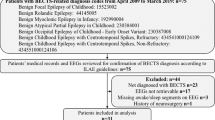Summary
The occurrence of spikes during an electroencephalogram is a basic feature of Benign Rolandic Epilepsy of Childhood (BREC). In this study we addressed the question of whether the interictal spike structure is different between "typical" and "atypical" BREC patients. Atypical BREC patients are characterized by having other neurological abnormalities in addition to the typical BREC symptoms. This question is of interest given the good prognosis associated with the typical form of BREC. We analyzed data from 12 typical and 12 atypical BREC patients using ten variables to describe spike morphology and topography. The non-parametric method of "classification and regression trees" (CART) was used to detect discriminating features and construct a classification rule. In this way the location and amplitude of the spike were found to provide satisfactory discrimination, suggesting that the two groups may be affected by different epileptic processes. The study showed the effectiveness of the CART methodology in dealing with the categorical and non-normal variables that can be obtained from EEG records. It illustrates a simple but logical approach to the analysis of potentially complex topographic data.
Similar content being viewed by others
References
Bartels, P.H. and Bartels, H.G. Classification strategies for topographic mapping data. In: F.H. Duffy (Ed.), Topographic Mapping of Brain Electrical Activity. Butterworths, Boston. 1986.
Bencivenga, R. A statistical analysis of electroencephalographic spikes in benign Rolandic epilepsy of childhood. M. Sc. Thesis, Department of Statistics, The University of British Columbia., 1987.
Breiman, L., Friedman, J.H., Olshen, R.A. and Stone, C.J. Classification and regression trees. Wadsworth Int., Belmont, California, 1984.
Dillon, W.R. and Goldstein, M. Multivariate analysis, methods and applications. John Wiley and Sons Inc., New York, N.Y., 1984.
Duffy, F.H., Denckla, M.B., Bartels, P.H., Sandini, G. and Kiessling, L.S. Dyslexia: Automated diagnosis by computerized classification of brain electrical activity. Ann.Neurol., 1980, 7: 421–428.
Gregory D.L. and Wong P.K.H. Topographical analysis of the centrotemporal discharges in benign Rolandic epilepsy of childhood. Epilepsia, 1984, 25(6): 705–711.
Hand, D.J. Discrimination and classification. John Wiley, Chicester, 1981.
Johnson, R.A. and Wichern, D.W. Applied multivariate statistical analysis. Prentice-Hall Inc., Englewood Cliffs, New Jersey, 1982.
Lehmann, D. Spatial analysis of evoked and spontaneous EEG potential fields. In: N. Yamaguchi and K. Fujisawa (Eds.), Recent Advances in EEG and EMG Data Processing. Elsevier/North-Holland Biomedical Press, 1981.
Lehmann, D., Ozaki, H. and Pal, I. EEG alpha map series: Brain micro-states by space-oriented adaptive segmentation. Electroenceph. clin. Neurophysiol., 1981, 67(3): 271–288.
Lerman, P., Kivity, S. Benign focal epilepsy of childhood. A follow-up study of 100 recovered patients. Arch.Neurol. 1975, 32: 261–264.
Lerman, P. and Kivity, S. Benign focal epilepsies of childhood. In: T.A. Pedley and B.S. Meldrum (Eds.), Recent Advances In Epilepsy. Vol. 3. 1986, 137–156, Churchill Livingston, New York, N.Y.
Lombroso, C. Sylvian seizures and midtemporal spike foci in children. Arch.Neurol., 1967, 17:52–59.
Marcos, J., Ramsay, E.R., Douchoney, M. and Wong, P.K.H. Centro-temporal spikes in childhood are not always indicative of a benign prognosis. Epilepsia. 1984, (5) 25: 653
Morgan, J.N. and Messenger, R.C. THAID: A sequential search program for the analysis of nominal scale dependent variables. Institute for Social Research, University of Michigan, Ann Arbour., 1973.
Myers, R.H. Classical and modern regression with applications. PWS Publishers, Boston., 1986.
Stone, M. Cross-validation: a review. Math.Operation-forsch.Statist.Ser.Statist., 1977, 9: 127–139.
Taylor, J., Bartels, P.H., Bibbo, M. and Wied, G.L. Automated hierarchic decision structures for multiple category cell classification by TICAS. Acta Cytol., 1978, 22: 261–267.
Weinberg, H., Brickett, P., Coolsma, F. and Baff, M. Magnetic localisation of intracranial dipoles: Simulation with a physical model. Electroenceph. clin. Neurophysiol. 1986, 64: 159–170.
Wong P.K.H., Gregory, D. and Farrell, K. Comparison of spike topography in typical and atypical benign Rolandic epilepsy of childhood. Electroenceph. clin. Neurophysiol., 1985, 61: S47.
Wong, P.K.H. and Weinberg, H. Source estimation of scalp EEG focus. In: G. Pfurtscheller and F. Lopes da Silva (Eds.), Functional Brain Imaging. Hans Huber Publishers, Toronto., 1986.
Author information
Authors and Affiliations
Rights and permissions
About this article
Cite this article
Wong, P.K.H., Bencivenga, R. & Gregory, D. Statistical classification of spikes in Benign Rolandic Epilepsy. Brain Topogr 1, 123–129 (1988). https://doi.org/10.1007/BF01129177
Accepted:
Issue Date:
DOI: https://doi.org/10.1007/BF01129177




